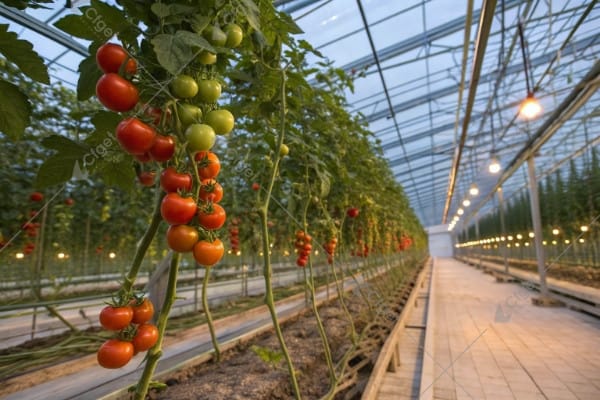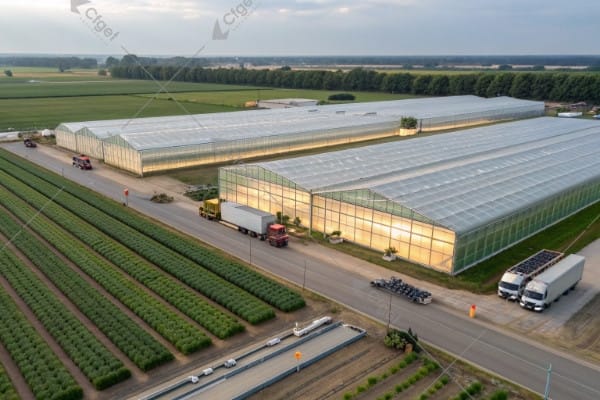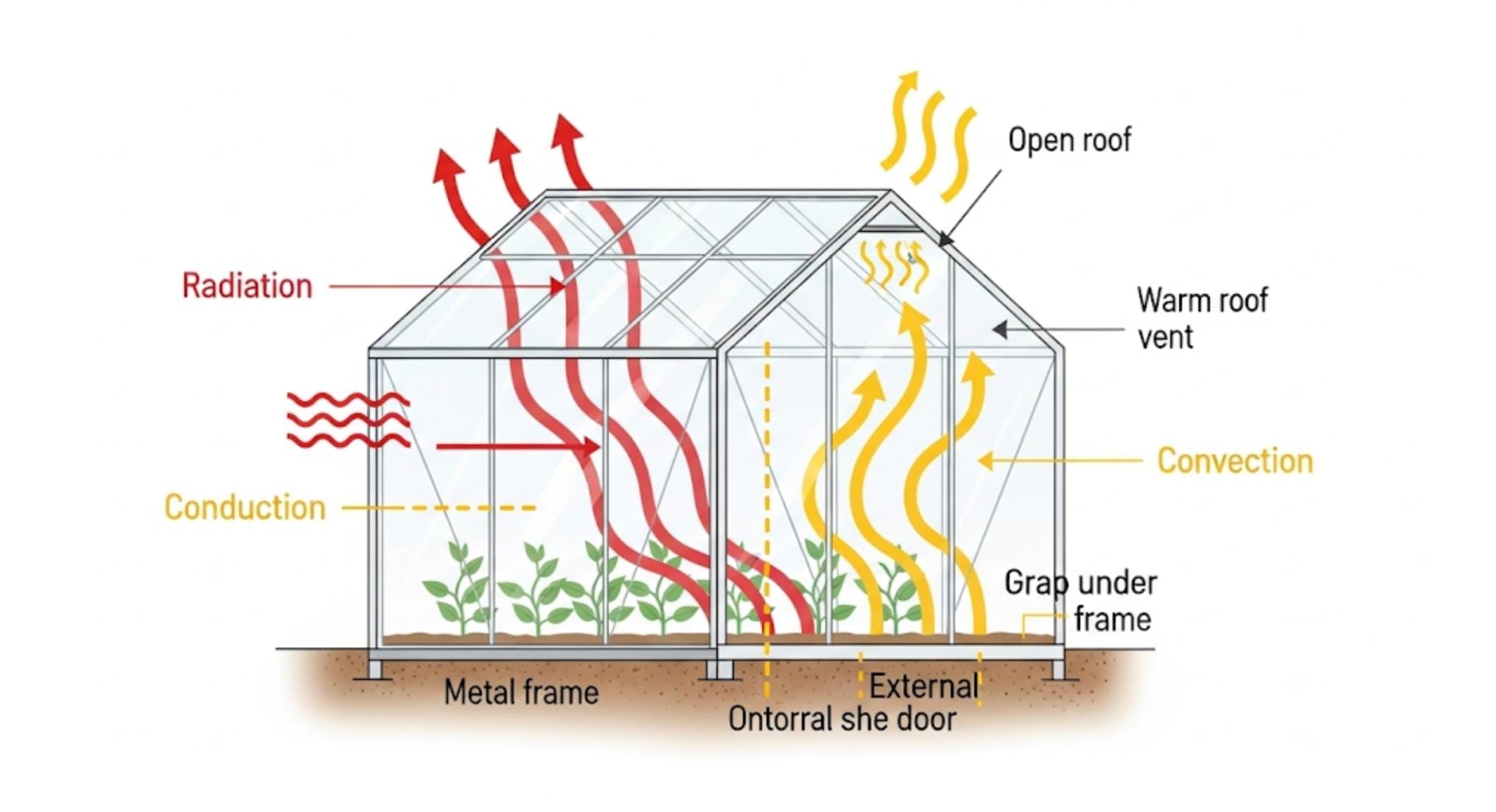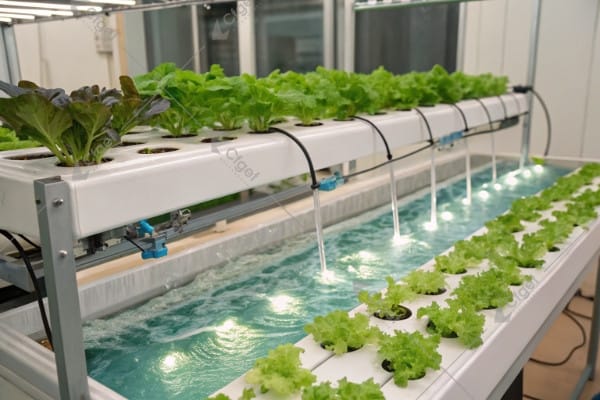Are you struggling with unpredictable weather, pests, and inconsistent yields? Traditional farming faces many challenges. Greenhouse farming offers a controlled environment, promising better results and reliability for your crops.
Yes, greenhouse farming significantly boosts crop production by increasing yields, enabling year-round cultivation, providing precise quality control, and protecting plants from pests and harsh weather. It creates an optimal, stable environment for plants to thrive, maximizing output and consistency.
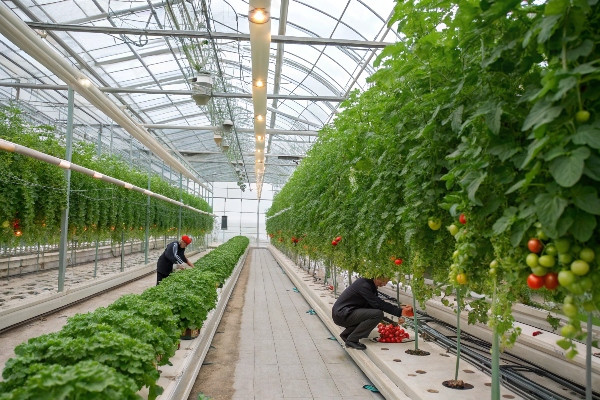
Over my years working with growers worldwide at CFGET, I’ve seen firsthand the incredible difference greenhouses make. From small family farms to large agricultural operations, the desire for more control and better results is universal. Greenhouse technology provides that control, moving beyond the limits of open-field farming. Let’s explore how.
Don’t miss out:—— What is a hydroponic greenhouse?
Boosting Crop Yields with Greenhouse Farming: Techniques and Best Practices?
Tired of yields being at the mercy of the weather? Greenhouses offer a powerful solution. By controlling the growing environment, you can push productivity far beyond what’s possible outdoors.
Absolutely. Greenhouses boost yields by optimizing growing conditions like temperature, light, and nutrients. Techniques such as hydroponics, vertical farming, and precise climate control allow plants to reach their full potential, often producing significantly more per square foot than traditional methods.
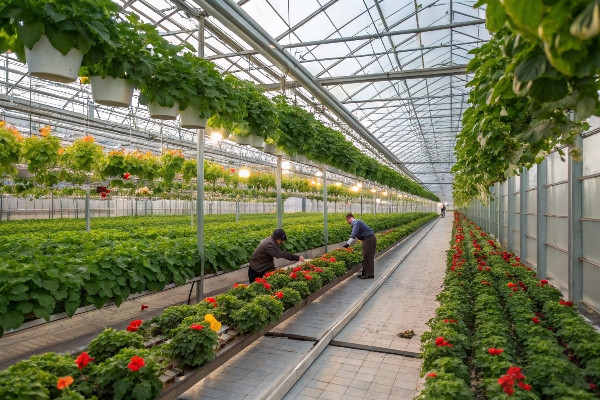
Boosting yields isn’t just about protection; it’s about actively enhancing growth. In my experience, seeing projects develop from concept to high-production facilities is always rewarding. We worked on a project in Southeast Asia where switching to hydroponics within a CFGET greenhouse tripled their lettuce yield compared to their previous field production. The key is understanding and applying the right techniques. It involves more than just putting up walls and a roof; it requires integrating systems that work together. You need to consider the specific crop, the local climate, and the grower’s goals. For instance, growers in Europe often focus heavily on resource efficiency, using advanced monitoring to minimize water and fertilizer use while maximizing yield, meeting strict sustainability standards.
What Are the Core Techniques for Maximizing Yields?
Optimizing the inputs plants receive is fundamental. This means going beyond just basic shelter.
Hydroponics and Aeroponics: Growing without soil allows for precise nutrient delivery directly to the roots. This eliminates soil-borne diseases and allows plants to absorb nutrients more efficiently.
- Hydroponics: Plants grow in nutrient-rich water solutions. Systems like Nutrient Film Technique (NFT) or Deep Water Culture (DWC) are common. We’ve implemented NFT systems for leafy greens in regions with poor soil quality, dramatically increasing production cycles.
- Aeroponics: Roots are suspended in the air and misted with nutrient solutions. This uses even less water than hydroponics and provides excellent oxygenation, often leading to faster growth. It’s more complex but highly effective for certain high-value crops.
Climate Control: Maintaining optimal temperature, humidity, and CO2 levels is crucial.
- Temperature: Heating and cooling systems tailored to the local climate are essential. In Central Asia, our greenhouses need robust heating for winter and effective ventilation for summer. We use sensors and automated systems to keep the temperature within the ideal range for the specific crop, day and night.
- Humidity: High humidity, common in Southeast Asia, requires dehumidification or ventilation strategies. Conversely, dry climates might need humidifiers. Proper humidity control prevents fungal diseases and optimizes transpiration.
- CO2 Enrichment: Supplementing CO2 can significantly boost photosynthesis and growth rates, especially for crops like tomatoes and peppers. We often integrate CO2 systems based on crop needs and ventilation rates.
Optimized Lighting: Supplemental lighting ensures plants receive enough light, especially during shorter days or cloudy weather.
- LED Technology: Modern LEDs are energy-efficient and can be tailored to specific light spectrums plants need for different growth stages (vegetative vs. flowering). European clients, focused on sustainability, increasingly adopt LEDs.
- Light Duration (Photoperiod): Controlling the length of "day" and "night" can trigger flowering or promote vegetative growth, depending on the crop. Automated lighting systems manage this precisely.
Here’s a simple comparison of yield potential:
| Feature | Traditional Farming | Basic Greenhouse | Advanced Greenhouse (Hydroponics, Climate Control, LEDs) |
|---|---|---|---|
| Yield Factor | 1x (Baseline) | 2x – 5x | 5x – 20x+ (Crop Dependent) |
| Water Use | High | Moderate | Low |
| Pest Control | Reactive (Sprays) | Preventative | Integrated & Preventative |
| Consistency | Low | Moderate | High |
How Do Best Practices Ensure Continued High Yields?
Implementing technology is only part of the equation. Consistent high yields depend on effective management and continuous improvement.
- Integrated Pest Management (IPM): Instead of relying solely on chemical pesticides, IPM uses monitoring, biological controls (beneficial insects), and targeted interventions. This protects beneficial organisms and reduces chemical residues, often a requirement for European markets. We help growers set up scouting programs and introduce beneficials appropriate for their crops and region.
- Nutrient Management: Regular testing of nutrient solutions (in hydroponics) or soil/substrate (if used) is vital. Adjusting nutrient formulas based on the crop’s growth stage ensures optimal uptake and prevents deficiencies or toxicities. Automated dosing systems simplify this process.
- Pruning and Training: Techniques like pruning lower leaves, trellising vining plants (like tomatoes or cucumbers), and managing plant density ensure good airflow, light penetration, and focus the plant’s energy on fruit production. I remember visiting a cucumber grower in Central Asia whose yields jumped significantly after implementing a high-wire trellising system we recommended.
- Data Monitoring and Analysis: Using sensors to track environmental conditions, nutrient levels, and even plant growth provides valuable data. Analyzing this data helps identify trends, predict problems, and make informed decisions to optimize conditions continually. Many of our larger clients integrate sophisticated farm management software.
- Hygiene Protocols: Strict hygiene is essential to prevent disease outbreaks. This includes foot baths, tool sterilization, and controlling who enters the greenhouse. It’s a simple but critical practice we emphasize in all our projects, from Southeast Asia to the Americas.
By combining advanced techniques with sound management practices, greenhouse farming consistently delivers higher yields than traditional methods. It’s about creating the perfect environment and giving plants exactly what they need, when they need it. Our experience across diverse climates and markets confirms that while the specific approach might vary, the potential for significantly increased productivity is universal.
Year-Round Growing: The Key Benefit of Greenhouse Farming?
Do seasonal changes dictate your planting and harvesting schedule? Imagine growing fresh produce regardless of the season outside. Greenhouses make this a reality, offering continuous production cycles.
Definitely. Greenhouses decouple food production from external weather conditions and seasons. By maintaining optimal growing conditions internally, they allow for continuous planting and harvesting throughout the year, ensuring a steady supply of fresh produce.
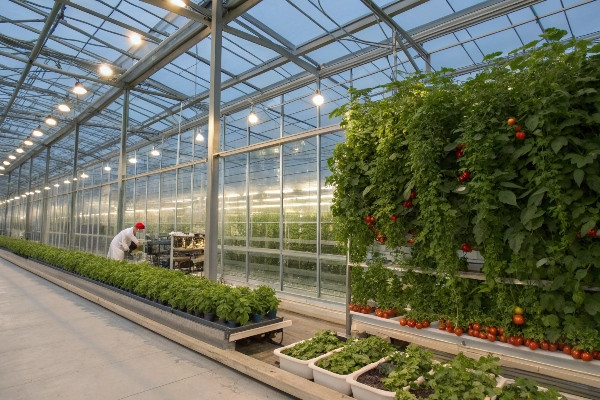
This ability to grow year-round is perhaps the most transformative aspect of greenhouse farming. I recall a project with a berry grower in a region with harsh winters. Before the greenhouse, their season was limited to a few summer months. Now, they supply fresh berries locally throughout the year, creating a stable income stream and meeting local demand. This consistency is invaluable, not just for grower profitability but also for local food security. It eliminates the ‘off-season’ lull that plagues traditional agriculture, providing fresh food and stable employment consistently. Whether it’s avoiding the monsoon rains in Southeast Asia, the freezing temperatures in Central Asia, or simply extending the growing season in temperate European climates, year-round production is a game-changer.
How Does Year-Round Production Work in Practice?
Achieving continuous cultivation requires careful management of the greenhouse environment and cropping cycles.
Climate Independence: The core principle is creating an internal microclimate shielded from external extremes.
- Heating: In colder regions (like parts of Europe or Central Asia), reliable heating systems are paramount for winter production. Options range from basic hot air furnaces to sophisticated hot water systems using boilers fueled by gas, biomass, or even geothermal energy. Efficiency and fuel cost are major considerations.
- Cooling: In hot climates (common in Southeast Asia or summer months elsewhere), cooling is essential. This can involve passive methods like shade cloths and natural ventilation, or active systems like fan-and-pad evaporative cooling or fogging systems. The choice depends on the required temperature drop and local humidity levels. We often design ventilation systems specifically to handle high humidity in tropical regions.
- Lighting: As mentioned earlier, supplemental lighting compensates for short winter days or cloudy periods, ensuring plants receive enough light energy for photosynthesis year-round. This is critical for maintaining consistent growth rates and achieving production targets during low-light months.
Succession Planting: This involves staggering planting dates so that crops are continuously reaching maturity and being harvested.
- Planning: Careful planning is needed to determine planting intervals based on the crop’s growth cycle (days to maturity). For leafy greens with short cycles, plantings might occur weekly. For fruiting crops like tomatoes, harvesting can be continuous from mature plants for several months.
- Nursery Area: Often, seedlings are started in a dedicated nursery area within the greenhouse or a separate structure. This allows mature plants in the main growing area to continue producing while the next batch of seedlings develops, maximizing space utilization and ensuring a seamless transition between cycles.
Crop Selection: Choosing crops suited to greenhouse production and potentially continuous harvest models is important.
- Suitable Crops: Many vegetables (tomatoes, peppers, cucumbers, lettuce, herbs), fruits (strawberries, raspberries), and flowers thrive in controlled environments.
- Cultivar Choice: Selecting cultivars specifically bred for greenhouse conditions (e.g., disease resistance, specific growth habits) can further enhance year-round success.
What Are the Economic and Social Impacts of Year-Round Growing?
The ability to produce continuously has far-reaching benefits beyond just having fresh food off-season.
- Market Stability: Growers can supply markets consistently, avoiding the price fluctuations associated with seasonal gluts and shortages. This allows for better planning and potentially long-term contracts with buyers (retailers, restaurants). I’ve seen our clients secure premium prices for off-season produce.
- Improved Cash Flow: Continuous harvesting means continuous revenue, improving the financial stability of the farm business compared to the seasonal income peaks and troughs of traditional farming.
- Local Food Security: Producing food locally year-round reduces reliance on long-distance transport and imports, which can be expensive and subject to disruption. This is particularly important for remote communities or regions with challenging import logistics. We see this as a major driver for greenhouse adoption in Central Asia.
- Stable Employment: Year-round operations provide consistent work for farm labor, rather than seasonal employment. This contributes to rural economies and provides better livelihoods for workers.
- Reduced Post-Harvest Losses: Harvesting smaller quantities more frequently, as enabled by succession planting, can sometimes lead to less spoilage compared to harvesting a large seasonal crop all at once.
Here’s a table outlining the contrast:
| Aspect | Traditional Seasonal Farming | Greenhouse Year-Round Farming |
|---|---|---|
| Production Cycle | Limited by Season (e.g., 3-6 mos) | Continuous (12 mos) |
| Market Supply | Seasonal Peaks & Gaps | Consistent, Steady Supply |
| Revenue Stream | Seasonal / Intermittent | Consistent / Continuous |
| Labor Needs | Seasonal Peaks | Stable, Year-Round |
| Reliance on Imports | High (Off-Season) | Low / Reduced |
| Climate Risk | High | Low (Managed Internally) |
In essence, year-round greenhouse farming transforms agriculture from a seasonally restricted activity into a continuous, reliable production system. It empowers growers with control over their production schedule, market supply, and financial stability, making it a cornerstone advantage of controlled environment agriculture. My work across CFGET’s diverse international projects constantly reinforces how valuable this capability is for producers everywhere.
Controlling the Environment: Optimizing Growth in Greenhouse Farming?
Do you feel frustrated by how external factors limit your plants’ potential? Greenhouses let you take charge, creating the perfect conditions for optimal growth, regardless of the weather outside.
Precisely. Greenhouses enable meticulous control over key environmental factors like temperature, humidity, light, water, nutrients, and CO2. This optimization allows plants to grow faster, healthier, and produce higher quality yields by minimizing stress and maximizing photosynthesis.
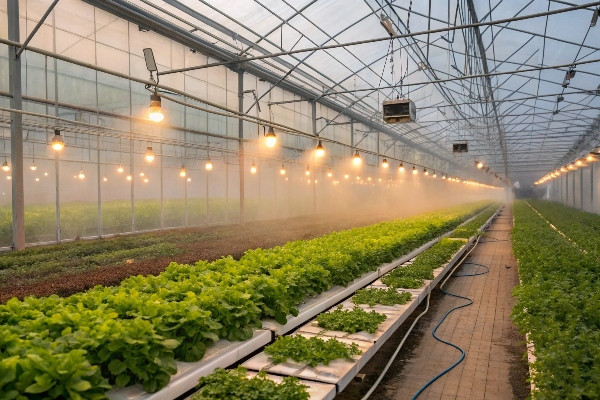
Creating the ideal microclimate is the heart of greenhouse farming. It’s about fine-tuning every element that affects plant growth. I remember visiting a research institution client in Europe that was using one of our advanced greenhouses. They were studying the precise impact of minute changes in CO2 levels and light spectrum on the flavor profile of basil. That level of control is simply impossible in an open field. It allows growers and researchers to push the boundaries of plant science and productivity. This control ensures resources like water and fertilizer are used efficiently, aligning with the sustainability goals important to many clients, especially in Europe and North America.
What Specific Environmental Factors Can Be Controlled?
Greenhouses offer levers to manage virtually every aspect of the plant’s surroundings.
Temperature: Maintaining the optimal temperature range for a specific crop is critical for metabolic processes and growth rates.
- Heating Systems: As discussed, crucial for cold periods. Options include forced air, hot water pipes (often near the root zone), or radiant heat. Precision is key – thermostats linked to automated systems maintain setpoints. CFGET designs consider fuel efficiency and heat distribution uniformity, vital for growers in colder climates like Central Asia.
- Cooling Systems: Essential for hot periods. Ventilation (natural or forced), shade screens (internal or external), evaporative cooling (fan-and-pad or fogging), and even air conditioning in specific high-value cases. We often recommend specific cooling strategies based on regional climate data, like prioritizing robust ventilation and humidity management for Southeast Asia.
- Day/Night Differentials (DIF): Controlling the difference between day and night temperatures can influence plant height and development.
Humidity: Relative Humidity (RH) affects transpiration, nutrient uptake, and disease pressure.
- Dehumidification: Important in humid climates or tightly sealed greenhouses. Achieved through ventilation (exchanging moist internal air with drier external air) or dedicated dehumidifiers (heat pump or desiccant based). Preventing condensation is key to controlling fungal diseases like botrytis.
- Humidification: Necessary in dry climates or when heating systems dry out the air. Fogging or misting systems can add moisture to maintain optimal RH levels.
Light: Controlling light intensity, duration (photoperiod), and quality (spectrum) optimizes photosynthesis.
- Supplemental Lighting: LEDs or HPS lamps provide light during low-light conditions. Control systems can adjust intensity and duration based on ambient light levels and crop needs.
- Shade Systems: Reduce excessive light intensity and heat during bright, hot periods. Automated shade screens can deploy based on sensor readings.
- Blackout Systems (Light Deprivation): Used to control photoperiod, primarily for inducing flowering in short-day plants like cannabis or chrysanthemums, regardless of the natural day length.
Carbon Dioxide (CO2): Enriching CO2 levels (typically from ambient ~400 ppm up to 800-1200 ppm, depending on the crop and light levels) can significantly boost photosynthetic rates and yields.
- CO2 Generators/Sources: Using propane/natural gas burners or pure CO2 injection from tanks. Requires careful monitoring and integration with ventilation systems to maintain target levels without reaching harmful concentrations.
Water and Nutrients (Fertigation): Controlled environment agriculture often combines environmental control with precise water and nutrient delivery.
- Drip Irrigation: Delivers water and dissolved nutrients directly to the root zone, minimizing waste.
- Hydroponics/Aeroponics: Soil-less systems offer the ultimate control over root-zone conditions and nutrient recipes.
- Automated Systems: Sensors monitor substrate moisture or nutrient solution parameters (EC, pH), and automated systems adjust irrigation frequency and nutrient dosing accordingly. This precision is highly valued by our research institution clients and high-value crop producers.
How Does Automation Enhance Environmental Control?
Modern greenhouses increasingly rely on automation for precise and efficient management.
- Sensors: Continuously monitor temperature, humidity, light levels (PAR), CO2 concentration, substrate moisture, water EC/pH, and sometimes even plant temperature.
- Controllers: Centralized computer systems receive data from sensors and activate/deactivate equipment (heaters, vents, fans, lights, irrigation pumps, CO2 injectors) based on pre-set parameters or complex algorithms.
- Remote Access: Many systems allow growers to monitor and adjust conditions remotely via smartphone or computer, providing flexibility and rapid response capabilities. This is crucial for large operations or growers managing multiple sites.
- Data Logging & Analysis: Automated systems log historical data, allowing growers to analyze trends, correlate environmental conditions with crop performance, and refine their control strategies over time.
Here’s a table illustrating the impact of control on key growth factors:
| Factor | Uncontrolled (Open Field) | Controlled (Greenhouse) | Impact of Control |
|---|---|---|---|
| Temperature | Fluctuates wildly | Stable, Optimal Range | Consistent Growth, Reduced Stress, Higher Yield |
| Humidity | Variable, often extreme | Managed within Ideal Range | Reduced Disease, Better Nutrient Uptake |
| Light | Variable (Day/Night, Cloud) | Optimized Intensity & Duration | Maximum Photosynthesis, Year-Round Growth |
| Water | Rain-dependent / Flood Irr. | Precise Delivery (Drip/Hydro) | Water Savings, Optimal Hydration, Nutrient Control |
| Pests | High Exposure | Reduced Exposure / IPM | Less Damage, Lower Pesticide Use |
| CO2 | Ambient (~400 ppm) | Ambient or Enriched (800+ ppm) | Potential for Significantly Increased Growth Rates |
Ultimately, controlling the environment allows growers to shift from reacting to nature to proactively managing it. It unlocks the full genetic potential of crops by providing exactly what they need for optimal performance. This level of precision, adaptable to different crops and regional challenges, is what makes greenhouse farming such a powerful tool for modern agriculture, a fact I see proven daily through CFGET’s global projects.
Greenhouse Farming Protect crops from Pests?
Are pests and diseases constantly threatening your harvest and profits? Greenhouses provide a physical barrier, significantly reducing the entry and spread of many common agricultural problems.
Yes, the enclosed structure of a greenhouse acts as a primary defense against airborne pests, insects, birds, and larger animals. Combined with controlled entry points and hygiene protocols, it dramatically lowers pest pressure compared to open-field cultivation.
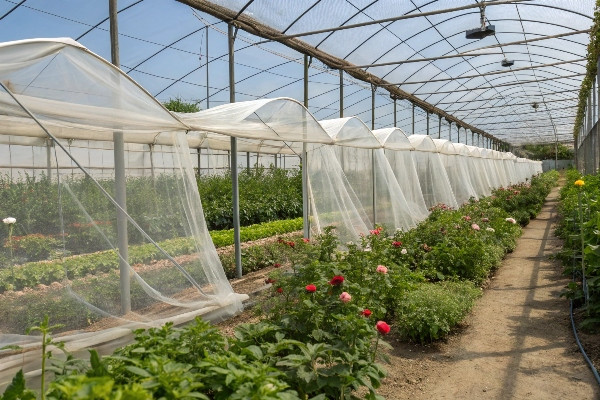
One of the most immediate benefits growers notice after switching to greenhouse farming is the reduction in pest damage. I’ve talked to countless farmers who were spending significant amounts on pesticides and still losing portions of their crops. In the greenhouse, while vigilance is still needed, the scale of the problem is vastly reduced. It creates a more manageable situation where preventative measures and targeted interventions are much more effective. This is a major advantage, especially for organic growers or those supplying markets with strict limits on pesticide residues, like many in Europe. It also reduces the risk of devastating outbreaks that can wipe out an entire field crop.
How Does the Greenhouse Structure Itself Provide Protection?
The physical enclosure is the first line of defense.
Physical Barrier: The greenhouse covering (glass, polycarbonate, or polyethylene film) prevents many pests from reaching the crops.
- Insects: Flying insects like aphids, thrips, whiteflies, and moths have difficulty entering a well-sealed greenhouse.
- Birds and Animals: Larger pests like birds, rodents, deer, or rabbits that can cause significant damage in fields are excluded.
- Disease Spores: While microscopic spores can still potentially enter, the barrier reduces the influx of windblown fungal and bacterial pathogens compared to open fields.
Controlled Entry Points1: Doors and vents are potential entryways, but they can be managed.
- Screening: Installing insect screens on all vents and openings is crucial. The mesh size must be chosen carefully to exclude target pests (e.g., thrips require very fine mesh) while still allowing adequate airflow. This is a standard feature we incorporate based on regional pest pressures, for example, using specific screens in Southeast Asia to combat prevalent small insects.
- Double-Door Systems: An anteroom or double-door entry helps create an airlock effect, reducing the chance of pests flying in when personnel enter or exit.
- Restricted Access: Limiting who enters the greenhouse minimizes the risk of pests or diseases being carried in on clothing or tools.
Foundation and Ground Cover: Proper sealing at the base of the greenhouse prevents crawling insects and rodents from entering. Using ground cover fabric inside suppresses weeds (which can host pests) and creates a cleaner environment.
What Other Strategies Enhance Pest Protection in Greenhouses?
Beyond the physical structure, proactive management strategies are key.
Integrated Pest Management (IPM)2: This holistic approach is particularly effective in the controlled greenhouse environment.
- Scouting/Monitoring: Regular inspection of crops (using sticky traps, visual checks) to detect pests early before populations explode. Early detection allows for targeted, less disruptive interventions.
- Cultural Controls: Practices like selecting resistant varieties, maintaining good plant spacing for airflow, and removing infested plant debris promptly.
- Physical Controls: Using sticky traps not just for monitoring but also for mass trapping of certain flying insects.
- Targeted Chemical Use: Using pesticides only as a last resort, selecting targeted (less broad-spectrum) and preferably bio-rational options, and applying them carefully to minimize impact on beneficials.
Strict Hygiene Protocols: Preventing pests and diseases from being introduced in the first place.
- Clean Plant Material: Starting with certified disease-free seeds or seedlings is critical. Quarantining new plants before introducing them to the main growing area can be beneficial.
- Tool and Equipment Sterilization: Regularly cleaning and disinfecting tools, pots, and irrigation equipment.
- Worker Hygiene: Providing footbaths with disinfectant at entrances and encouraging hand washing. Ensuring workers don’t move directly from potentially infested outdoor areas into the greenhouse without changing clothes or footwear. I’ve seen simple hygiene lapses lead to significant problems, reinforcing the importance of training and consistency.
Environmental Management: Optimizing the climate can make conditions less favorable for certain pests or diseases. For example, managing humidity can suppress fungal growth, and maintaining optimal plant health makes crops less susceptible to opportunistic pests.
Here’s a comparison of pest pressure and management:
| Aspect | Open Field Farming | Greenhouse Farming |
|---|---|---|
| Pest Exposure | High, Constant | Low, Controlled Entry |
| Pest Entry Points | Everywhere | Vents, Doors (Screenable) |
| Initial Infestation | Frequent, Widespread | Less Frequent, Often Localized |
| Management Focus | Reactive Spraying | Preventative (Exclusion, Hygiene) |
| Control Methods | Broad-Spectrum Pesticides Common | IPM, Biological Control3 Favored |
| Pesticide Use | High | Significantly Reduced / Eliminated |
| Crop Loss Risk | High | Lower |
The protected environment of a greenhouse shifts the balance of power in favor of the grower. While no system is completely pest-proof, greenhouses provide the tools and control needed to manage pests much more effectively and sustainably than is typically possible outdoors. This protection is fundamental to achieving the high yields and quality associated with greenhouse farming, a benefit consistently valued by CFGET clients across all regions.
Conclusion
Greenhouse farming offers clear advantages: higher yields, year-round production, precise quality control, and better pest management. It empowers growers with control, leading to more reliable and often more profitable agriculture.
Discover the importance of Controlled Entry Points in reducing pest entry and maintaining a healthy greenhouse environment. ↩
Explore this resource to understand how IPM can enhance pest control in greenhouses, leading to sustainable and effective farming practices. ↩
Learn about Biological Control methods that utilize beneficial insects to manage pests, promoting a healthier ecosystem in your greenhouse. ↩

